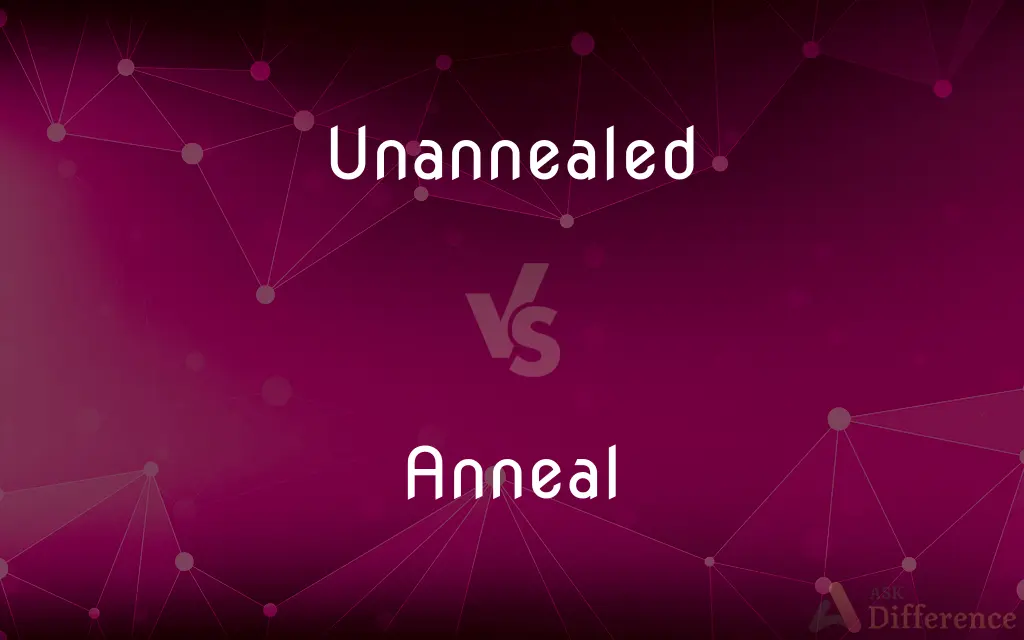Unannealed vs. Anneal — What's the Difference?
By Urooj Arif & Fiza Rafique — Updated on April 16, 2024
Unannealed materials remain untreated by heat, retaining original hardness and brittleness, while annealing softens materials through controlled heating and cooling.

Difference Between Unannealed and Anneal
Table of Contents
ADVERTISEMENT
Key Differences
Unannealed materials are those that have not undergone any form of heat treatment to alter their properties, often resulting in a harder and more brittle state. In contrast, the process of annealing involves heating a material to a specific temperature and then cooling it slowly, usually to remove stresses, increase softness, and improve ductility.
The main purpose of keeping materials unannealed is to maintain their original mechanical properties, which might be crucial for certain applications that require high strength and wear resistance. On the other hand, annealing is employed to make materials easier to work with, especially in terms of machining, forming, and shaping.
In metallurgy, unannealed metals can be difficult to work with due to their toughness and potential to crack. Whereas annealing can enhance the workability of these metals, making them suitable for various manufacturing processes that involve plastic deformation.
The structural integrity of unannealed materials might be preferable for certain uses where the material's natural state offers the best performance. Conversely, annealing can change the microstructure of the material, thereby tailoring its properties to better suit specific needs, such as improving corrosion resistance or electrical conductivity.
Temperature control is crucial in the annealing process to achieve desired material characteristics, whereas unannealed materials are utilized as-is, without the need for this additional processing step.
ADVERTISEMENT
Comparison Chart
Definition
Material not subjected to heat treatment
Process of heating and slowly cooling
State of Material
Harder, more brittle
Softer, more ductile
Purpose
Maintain original mechanical properties
Improve workability, reduce stresses
Suitability for Work
Less malleable, tougher
Easier to machine, shape, and form
Impact on Microstructure
No change to microstructure
Alters microstructure for desired properties
Compare with Definitions
Unannealed
Not altered by annealing.
The unannealed steel retained its initial tensile strength.
Anneal
Employed to enhance ductility and reduce hardness.
The anneal cycle made the copper wire easy to bend.
Unannealed
Retaining original hardness and brittleness without heat treatment.
The unannealed glass was more likely to shatter when dropped.
Anneal
To heat and cool a material to alter its physical properties.
To improve its malleability, the metal was annealed.
Unannealed
Used in its naturally occurring state.
Unannealed copper wires are less flexible but more durable.
Anneal
Softening of a material by heat treatment.
Anneal the glass to prevent cracking during the molding process.
Unannealed
Characterized by lack of softening processes.
Unannealed ceramics maintain a higher resistance to wear.
Anneal
A method to change the microstructure for specific properties.
Anneal the alloy to increase its conductivity.
Unannealed
Maintains original stress profile.
Unannealed metals are used where high strength is critical.
Anneal
Process used to relieve internal stresses.
Annealing the steel eliminated stress concentrations.
Unannealed
Not annealed.
Anneal
To subject (glass or metal) to a process of heating and slow cooling in order to toughen, reduce brittleness, or enhance adhesion.
Unannealed
(of metal or glass) not annealed and consequently easily cracked or fractured
Anneal
To strengthen or harden.
Anneal
To become strengthened or hardened
“the time she needed for opinion to anneal around her policy” (Alexander M. Haig, Jr.).
Anneal
(metallurgy) To subject to great heat and then (often slow) cooling, and sometimes reheating and further cooling, for the purpose of rendering less brittle; to temper; to toughen.
Anneal
To cool glass slowly, to minimize internal stress.
Anneal
(archaic) To burn colors onto a glass or other surface.
Anneal
To make a double-stranded nucleic acid by pairing a single strand with a complementary strand.
Anneal
To strengthen or harden.
The experience annealed them, strengthening their resolve.
Anneal
An act of annealing.
Anneal
To subject to great heat, and then cool slowly, as glass, cast iron, steel, or other metal, for the purpose of rendering it less brittle; to temper; to toughen.
Anneal
To heat, as glass, tiles, or earthenware, in order to fix the colors laid on them.
Anneal
Toughen (steel or glass) by a process of gradually heating and cooling;
Temper glass
Common Curiosities
What are the risks of not annealing materials that typically require it?
Without annealing, materials may retain internal stresses and defects, leading to potential failure in applications.
What industries commonly use unannealed materials?
Industries such as construction and aerospace often use unannealed materials for their structural integrity and resistance to deformation.
How does annealing improve the electrical properties of materials?
Annealing can increase the electrical conductivity of materials by reducing defects and aligning the crystal structure.
Is annealing an expensive process?
Annealing can be cost-intensive due to the energy required for heating and the need for controlled environments.
How does the thickness of a material affect its annealing process?
Thicker materials require longer heat treatment times and slower cooling rates to achieve uniform softness and stress relief.
How long does the annealing process take?
The duration of the annealing process varies depending on the material and desired properties but can range from hours to several days.
What is the difference between annealing and tempering?
Annealing softens materials by heating and slow cooling, whereas tempering increases toughness by heating and then rapid cooling.
Can annealing affect the color of a material?
Yes, in some metals, annealing can cause color changes due to alterations in surface oxidation.
What types of materials are most responsive to annealing?
Metals such as steel, copper, and aluminum, as well as glass and certain polymers, are highly responsive to annealing.
Can annealing be reversed?
Annealing changes are generally permanent, though materials can be further treated or re-hardened using other processes.
What are the environmental impacts of annealing?
The annealing process can have environmental impacts due to energy consumption and potential emissions from heating.
Are there any alternatives to annealing that can achieve similar results?
Alternatives such as stress relieving and normalization can achieve similar results in reducing internal stresses and altering material properties.
Can annealing be done at a small scale, such as in a home workshop?
Yes, annealing can be done on a small scale with the proper equipment to control the heating and cooling rates safely.
How do manufacturers ensure consistency in the annealing process?
Consistency is maintained through precise control of temperature, time, and cooling rates, often automated in modern facilities.
What tools are used to measure the effectiveness of annealing?
Tools such as microscopes for examining microstructures and hardness testers are used to assess the effectiveness of annealing.
Share Your Discovery

Previous Comparison
Feral vs. Wild
Next Comparison
Actinopterygii vs. SarcopterygiiAuthor Spotlight
Written by
Urooj ArifUrooj is a skilled content writer at Ask Difference, known for her exceptional ability to simplify complex topics into engaging and informative content. With a passion for research and a flair for clear, concise writing, she consistently delivers articles that resonate with our diverse audience.
Co-written by
Fiza RafiqueFiza Rafique is a skilled content writer at AskDifference.com, where she meticulously refines and enhances written pieces. Drawing from her vast editorial expertise, Fiza ensures clarity, accuracy, and precision in every article. Passionate about language, she continually seeks to elevate the quality of content for readers worldwide.













































